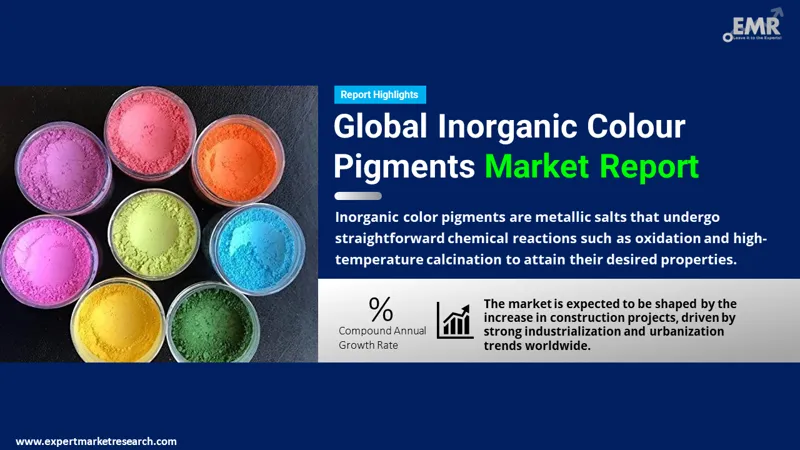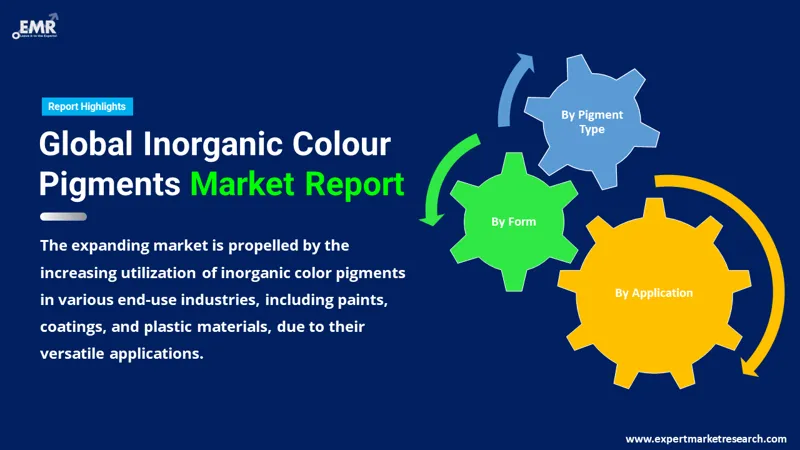
Consumer Insights
Uncover trends and behaviors shaping consumer choices today
Procurement Insights
Optimize your sourcing strategy with key market data
Industry Stats
Stay ahead with the latest trends and market analysis.
The global inorganic colour pigments market attained a value of USD 3.30 Billion in 2025. The market is further expected to grow in the forecast period of 2026-2035 at a CAGR of 3.20%, to reach USD 4.52 Billion by 2035.
Base Year
Historical Period
Forecast Period
Compound Annual Growth Rate
3.2%
Value in USD Billion
2026-2035
*this image is indicative*
The global market for inorganic colour pigments is being driven by the growing applications of the product in paints, coatings, plastics, and construction materials, among others. These pigments are produced by mixing metal oxides, owing to which their composition offers excellent physical properties like high tinting strength, heat stability, and extreme weather tolerance.

Read more about this report - REQUEST FREE SAMPLE COPY IN PDF
This is providing impetus to the market growth. In addition to this, the rise in residential, commercial, and industrial construction activities across the world, owing to expanding spending capacity, industrialisation, and urbanisation, the demand for inorganic colour pigments in paints and varnishes is stimulating the growth of the market. Furthermore, the market growth can be characterised by the increasing focus on aesthetics, which is propelling the market growth of inorganic colour pigments as these pigments do not cause the colour to fade when exposed to sunlight, making them durable and lowering maintenance costs. Thus, the added advantage of the cost-effectiveness of inorganic colour pigments is furthering the growth of the market.
Inorganic colour pigments are metallic salts that are subjected to simple chemical reactions like oxidation and high-temperature calcination. As opposed to organic colour pigments, inorganic colour pigments are easier to disperse, making them favourable for several applications.
On the basis of pigment type, the market can be divided into
Based on form, the market can be categorised into
The market, based on application, can be classified into
The EMR report looks into the regional markets of inorganic colour pigments

Read more about this report - REQUEST FREE SAMPLE COPY IN PDF
The market growth of inorganic colour pigments can be associated with the growing demand for surface treatment activities, along with the growing inclination towards better aesthetics in the automotive, construction, healthcare, and cosmetic industries. Properties such as reduced absorption of oil and dispersant make inorganic colour pigments an ideal choice for surface treatments. As a result, the demand for inorganic colour pigments is rising on account of durability.
Moreover, organic colour pigments are widely used in the plastic industry as colourants for manufacturing various plastic products, including toys, food packaging, automotive parts, and bottles, among others. The rising applicability of plastic products in various end-use industries owing to its cost-effectiveness, along with improving environmental properties, are additional factors positively influencing the market growth of inorganic colour pigments.
The report presents a detailed analysis of the following key players in the global inorganic colour pigments market, looking into their capacity, market shares, and latest developments like capacity expansions, plant turnarounds, and mergers and acquisitions:
The comprehensive report looks into the macro and micro aspects of the industry. The EMR report gives an in-depth insight into the market by providing a SWOT analysis as well as an analysis of Porter’s Five Forces model.




*While we strive to always give you current and accurate information, the numbers depicted on the website are indicative and may differ from the actual numbers in the main report. At Expert Market Research, we aim to bring you the latest insights and trends in the market. Using our analyses and forecasts, stakeholders can understand the market dynamics, navigate challenges, and capitalize on opportunities to make data-driven strategic decisions.*
Get in touch with us for a customized solution tailored to your unique requirements and save upto 35%!
In 2025, the global inorganic colour pigments market attained a value of more than USD 3.30 Billion.
The market is projected to grow at a CAGR of 3.20% between 2026 and 2035.
The market is being driven by the growing applications of inorganic colour pigments in paints, coatings, and plastic materials used in several end-use industries.
The market is anticipated to be defined by the spur in construction projects owing to robust industrialisation and urbanisation around the world.
The major regions in the industry are North America, Latin America, the Middle East and Africa, Europe, and the Asia Pacific.
The major pigment types of inorganic colour pigments are ultramarine, cadmium, bismuth pigments, iron and iron oxide, chrome pigment, and carbon black, among others.
The different forms of inorganic colour pigments are aqueous and powder.
The significant applications of inorganic colour pigments include paints and coatings, plastics, printing inks, roofing granules, and construction material, among others.
The major players in the industry are Ferro Corporation, Tronox, Venator Materials PLC, Heubach GmbH, and Lanxess AG, among others.
Explore our key highlights of the report and gain a concise overview of key findings, trends, and actionable insights that will empower your strategic decisions.
| REPORT FEATURES | DETAILS |
| Base Year | 2025 |
| Historical Period | 2019-2025 |
| Forecast Period | 2026-2035 |
| Scope of the Report |
Historical and Forecast Trends, Industry Drivers and Constraints, Historical and Forecast Market Analysis by Segment:
|
| Breakup by Pigment Type |
|
| Breakup by Form |
|
| Breakup by Application |
|
| Breakup by Region |
|
| Market Dynamics |
|
| Competitive Landscape |
|
| Companies Covered |
|
| Report Price and Purchase Option | Explore our purchase options that are best suited to your resources and industry needs. |
| Delivery Format | Delivered as an attached PDF and Excel through email, with an option of receiving an editable PPT, according to the purchase option. |
Datasheet
One User
USD 2,499
USD 2,249
tax inclusive*
Single User License
One User
USD 3,999
USD 3,599
tax inclusive*
Five User License
Five User
USD 4,999
USD 4,249
tax inclusive*
Corporate License
Unlimited Users
USD 5,999
USD 5,099
tax inclusive*
*Please note that the prices mentioned below are starting prices for each bundle type. Kindly contact our team for further details.*
Flash Bundle
Small Business Bundle
Growth Bundle
Enterprise Bundle
*Please note that the prices mentioned below are starting prices for each bundle type. Kindly contact our team for further details.*
Flash Bundle
Number of Reports: 3
20%
tax inclusive*
Small Business Bundle
Number of Reports: 5
25%
tax inclusive*
Growth Bundle
Number of Reports: 8
30%
tax inclusive*
Enterprise Bundle
Number of Reports: 10
35%
tax inclusive*
How To Order

Select License Type
Choose the right license for your needs and access rights.

Click on ‘Buy Now’
Add the report to your cart with one click and proceed to register.

Select Mode of Payment
Choose a payment option for a secure checkout. You will be redirected accordingly.
Gain insights to stay ahead and seize opportunities.

Get insights & trends for a competitive edge.

Track prices with detailed trend reports.

Analyse trade data for supply chain insights.

Leverage cost reports for smart savings

Enhance supply chain with partnerships.

Connect For More Information
Our expert team of analysts will offer full support and resolve any queries regarding the report, before and after the purchase.
Our expert team of analysts will offer full support and resolve any queries regarding the report, before and after the purchase.
We employ meticulous research methods, blending advanced analytics and expert insights to deliver accurate, actionable industry intelligence, staying ahead of competitors.
Our skilled analysts offer unparalleled competitive advantage with detailed insights on current and emerging markets, ensuring your strategic edge.
We offer an in-depth yet simplified presentation of industry insights and analysis to meet your specific requirements effectively.
Share